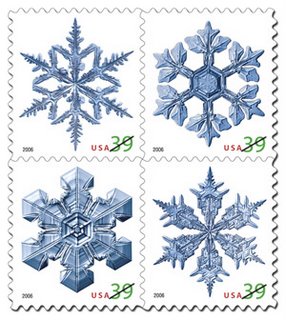Snowflake stamps

Thanks to Carol. This I find so interesting.. Hopefully I will get to see these stamps.. what a different design. Hope you enjoy seeing these.
Snowflakes generally take one of seven basic forms. For example, stellar, or starlike, snowflakes usually grow six primary branches that support arms, which often develop thin plates of ice at the ends. Bitter-cold conditions create crystals with more facets. The most symmetrical snowflakes occur during light snowfalls when there is cold weather and little wind. If the air is warmer, crystals tend to stick together to form less symmetrical snowflakes, or they can take on a needlelike shape. In higher humidity, snowflakes may branch more, making them dendritic, or plantlike, in appearance.
The Holiday Snowflakes stamps are photographs of two basic snowflake patterns by physicist Kenneth Libbrecht. They are stellar dendrites, which form branching treelike arms, and sectored plates, which as their name suggests, form platelike arms. Because fallen snowflakes start to melt and lose their shape in mere minutes, Libbrecht quickly transferred the snowflakes from cardboard to a glass slide using a paintbrush. He then snapped the photos inside a temperature-regulated enclosure using a digital camera attached to a high-resolution microscope.
Falling from thousands of feet, these intricate ice crystals commonly begin as a piece of dust tumbling through the clouds. Gathering water molecules, they blossom into crystal forms in endlessly different patterns because of the constantly changing conditions of the atmosphere.
Anyone else able to scan or copy or direct me to pictures of the Christmas stamps from your country so I can share then with others? Write to me at cddstamps@gmail.com
Have a great weekend.. Michael


0 Comments:
Post a Comment
<< Home